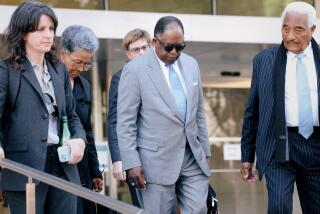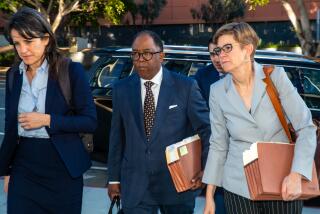Hedgecock Case: Formidable Challenge for Jury
- Share via
SAN DIEGO — While questioning prospective jurors in San Diego Mayor Roger Hedgecock’s felony retrial last month, Deputy Dist. Atty. Charles Wickersham constantly reminded them that, because the case hinged heavily on circumstantial evidence, their judgment would turn on “what inferences you draw” from certain facts.
To illustrate the task facing jurors, Wickersham often used this analogy: If rabbit footprints were spotted on an otherwise unblemished field of snow, the prosecutor said, “it would be reasonable to assume . . . that a rabbit had been there.”
Through 17 days of testimony from 61 prosecution witnesses, Wickersham believes that he has pointed out enough “footprints” for jurors to conclude that Hedgecock participated in a political conspiracy designed to help him win the 1983 mayoral campaign.
However, Hedgecock attorney Oscar Goodman, who dramatically rested the defense’s case last week without calling a single witness, invoked Wickersham’s analogy to describe what he perceives as the prosecution’s failure to prove its case.
‘A Lot of Footprints’
“We’ve seen a lot of footprints, but they aren’t the mayor’s and they don’t lead anywhere,” Goodman remarked.
When Hedgecock’s eight-woman, four-man jury returns to Superior Court this week for closing arguments in the much-publicized case, they will confront the challenge that Wickersham outlined for them at the outset--namely, trying to choose between the conflicting interpretations and diametrically opposed theories of the case that have emerged, often from the same set of facts.
“Many of the facts aren’t in dispute,” Goodman explained. “But what they mean, if anything, is (in dispute).”
From Hedgecock’s perspective, prosecutors have perverted routine political and business behavior into a complex conspiracy theory--seeing intrigue where there is none, finding sinister motives in innocuous actions.
“They came into this case with the assumption that there was some big conspiracy, so even if there’s evidence to show that something might be white, they’ve tried to find a way to make it look black,” Hedgecock said.
Financial Paths
Prosecutor Wickersham, however, contends that Hedgecock crossed financial paths with his alleged co-conspirators too many times--and inaccurately reported the resulting transactions on too many occasions--for those incidents to be merely unrelated coincidences. Hedgecock’s claim that he was unaware of the sources of money that benefited him, directly or indirectly--an explanation that he offers in regard to several of the key financial deals at issue in the case--is one that, through repetition, grows increasingly less credible, Wickersham argues.
“This case is just one solid string of things that (Hedgecock) didn’t know about,” Wickersham said. “How often can you say that and expect people to believe it?”
Prosecutors charge that, to become mayor, Hedgecock conspired with former J. David & Co. principals Nancy Hoover and J. David (Jerry) Dominelli in a scheme to funnel tens of thousands of dollars in allegedly illegal contributions to Hedgecock’s 1983 race, through a political consulting firm owned by Tom Shepard, a close friend of the mayor. Hedgecock also relied on Hoover’s and Dominelli’s largess, prosecutors contend, to transform his run-down South Mission Hills house into a mansion. To conceal the allegedly illegal transactions, Hedgecock falsified various financial disclosure statements, Wickersham contends.
An example of how the two sides draw completely opposite conclusions from the same event can be found in the testimony of John Woodard, a former Shepard employee who acted as Hedgecock’s chauffeur in the 1983 campaign.
Discussed Work
Woodard testified that, in the spring of 1983, he discussed the amount of work that Tom Shepard & Associates was doing on Hedgecock’s campaign with Robert Meadow, one of the firm’s founding partners, in the Shepard firm’s offices in a La Jolla building that was also occupied by J. David & Co.
When he asked how Shepard’s firm, which then had few other clients, was able to pay for all of the Hedgecock campaign work, Woodard said, Meadow “just looked at the ceiling and said, ‘I don’t know.’ ”
After a brief pause, and a knowing glance at the jury, Deputy Dist. Atty. David Cox, who assisted Wickersham, asked: “Whose office was above yours?”
“J. David & Co.,” Woodard answered.
Allege Overt Acts
Although prosecutors allege that Hedgecock committed 57 overt acts to further the purported conspiracy, the 15 felony charges and one misdemeanor count facing him focus on several overriding questions.
- Was the more than $360,000 that Dominelli and Hoover invested in Tom Shepard & Associates a legitimate business investment or an illegal subsidy to Hedgecock’s race?
Because Hedgecock’s campaign organization was the firm’s major client during most of that period, prosecutors argue that the investments were tantamount to illegal donations that helped prop up an integral component of his campaign.
Hedgecock has consistently denied knowing that any J. David & Co. money was flowing into Shepard’s firm, saying that he believed that Hoover was underwriting the company, and that she did so primarily to help Shepard start his own business, not to get Hedgecock elected mayor.
The defense also points out that $189,000 of Hoover’s and Dominelli’s investments were made before and after Hedgecock’s race--$95,000 after Hedgecock had already been elected in May, 1983--and, therefore, can hardly be viewed as an illegal campaign donation.
Sorrento Valley investment counselor Harvey Schuster, however, testified that Hedgecock had boasted to him in November, 1981, that Dominelli planned to finance Tom Shepard & Associates so that the firm would be able to run Hedgecock’s 1983 race.
That assertion by Schuster, arguably the major witness in the case, is the only direct evidence linking Hedgecock to the alleged plot to circumvent the city’s $250-per-person campaign contribution limit. It also marks one of the very few instances in which the two sides in the case disagree not simply on interpretations but on the facts themselves.
Goodman argued that Schuster lied in his testimony because of his anger over not receiving a lucrative 1982 contract to develop San Diego County’s bay-front parking lots. Hedgecock and his colleagues on the Board of Supervisors unanimously awarded that contract to another bidder.
- Did Hedgecock’s campaign receive free staff time and other services from Shepard’s firm, or was the contract between the campaign and the firm a valid one?
Cut-Rate Contract
Prosecutors argue that Shepard gave Hedgecock a cut-rate contract that resulted in a heavy financial loss for the consulting firm in the form of unreimbursed staff time, overhead costs and other services.
The defense contends that Shepard was willing to absorb a short-term financial loss, realizing that running a successful mayoral campaign could act as a magnet for other clients--which, in fact, proved to be the case.
Wickersham has pointed out, however, that Shepard and his employees did work for Hedgecock during the first half of 1982, before the firm had a contract to run the mayor’s campaign.
Goodman has elicited testimony from Meadow and others that the pre-August, 1982, work was done on a volunteer basis by Shepard’s staff members.
- Was the controversial $130,000, oral-agreement loan that Hedgecock received from Hoover to renovate his house an unorthodox but nevertheless legal transaction, or was the money originally intended to be a gift that probably would not have come to light were it not for J. David & Co.’s collapse in early 1984?
‘That’s Who I Paid’
From the beginning of the investigation into his finances, Hedgecock has insisted that the $130,000 loan, which he repaid last year with interest, came from Hoover. However, checks introduced as evidence showed that much of the $130,000 loan did, in fact, come from J. David & Co., not Hoover. Hedgecock acknowledged that Hoover and Dominelli may have “co-mingled their funds” without his knowledge, but added: “My deal was with Nancy. As far as I knew, that’s where the money came from and that’s who I paid.”
Perhaps the most dramatic moment in the trial, however, concerns not the extensive testimony that has been heard, but rather the testimony that will not be delivered. Last week, Goodman, characterizing the prosecution’s case as a “sand castle . . . that crumbled,” stunned courtroom observers by resting his case without presenting a single witness.
“Our feeling was, their witnesses were our witnesses . . . and so there was no need to present a defense,” Goodman said, arguing that he had already built his case through his cross-examination of prosecution witnesses. “It’s very clear to us that the prosecution has not met its burden of proof beyond a reasonable doubt.”
Goodman’s decision precluded a repeat of the dramatic highlight of the mayor’s first trial--Hedgecock’s three-day appearance on the witness stand. However, most of the jurors from the first case, which ended in a mistrial last February with the jury deadlocked 11 to 1 in favor of conviction, said that they believed that Hedgecock’s testimony was unpersuasive and that it damaged his own case.
Question of Motive
Therefore, while Goodman characterizes his bold decision as a sign of strength, prosecutors suggest that the defense attorney’s tactic actually may reflect his reluctance to have Hedgecock testify again.
In his instructions to the jury later this week, Judge William L. Todd Jr. will remind jurors that, because defendants have a constitutional right not to testify, the jurors should not draw any inferences--positive or negative--from Goodman’s decision not to present a defense.
However, both sides in the case concede that, human nature being what it is, individual jurors well may be affected, if only in a subliminal way, by the defense’s strategic gambit.
More to Read
Sign up for Essential California
The most important California stories and recommendations in your inbox every morning.
You may occasionally receive promotional content from the Los Angeles Times.









